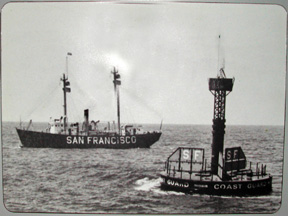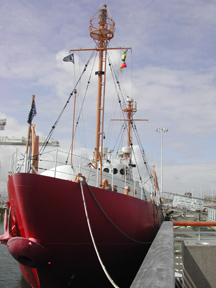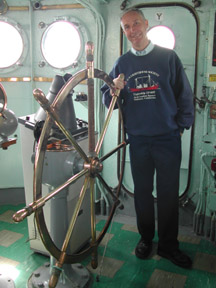She sits with her bright red hull against the gray docks at the very end of Oakland’s public wharf area. Look west of Jack London Square and Relief can be found there.

By Mary Swift-Swan
Published: April, 2004
She sits with her bright red hull against the gray docks at the very end of Oakland’s public wharf area. Look west of Jack London Square and Relief can be found there. It is a pleasant walk of 100 yards or so from Oakland’s Ferry Dock, past Teddy Roosevelt’s Presidential yacht the Potomac and past Oakland’s fireboat the Sea Wol,f, named with Jack London in mind. There she is protected from wind and sea. In her restful berth, the historic Lightship Relief is now open for tours Tuesday to Sunday, manned by John Bryne and the Relief crew of nearly two dozen volunteers from the U.S. Lighthouse Society. Relief is kept “…better than ever she was while in service of the US Coast Guard,” said one of her many volunteers. He should know. Of the two dozen volunteers, he is among the 50 percent who were in the USCG and possibly on the ship itself. The diligent care and obvious pride taken in the care of this unique vessel makes her a pleasure to tour. To board and tour Lightship Relief costs just $3 for adults, $2 for seniors 60 and older, and kids 17 and under are free! What a relief!
Lightships were anchored to provide major lights where the waters were too deep or hazardous to make erecting a permanent lighthouse impractical, but where mariners needed guidance around a reef or into a harbor. Lightship vessels were anchored with a mushroom anchor that weighed up to 7,500 lbs backed up with a Navy anchor for storms. In storms, sometimes the boat would roll up to 30 degrees each way making for hazardous duty even while anchored. A full crew was 18-20 men who rotated out for off time. They had duties to stand watch 4 on and 8 off in the wheelhouse or in engineering. Monday-Friday, 8-4 was the work week and if not on watch in the deck department, they’d chip and paint the deck, while the engineering department would do maintenance on machines and clean-up. There were cooks and two supervisory personal. For a 1950s military ship, the crew quarters are spacious. Each man had his own bunk–no hot bunking–where another gets into your bunk before it has a chance to cool. Each crew member had the luxury of their own locker. The ships were built to have a crew stay aboard for long periods of time. The galley is efficient and spacious compared to many in current charter operation. A buoy tender would come out to rotate off-duty crew every two plus weeks, also bringing fuel, mail, and fresh food supplies. Vessels used for this purpose on both coasts, like the San Francisco Lightship, had to come into port for periodic haul out, maintenance, or repairs. That is when a fully crewed Relief ship would come into play. Relief Lightships took over giving the Lightship Station uninterrupted coverage, fully manned 24 hours a day, year round, year after year.
A Lightship San Francisco was anchored 12.5 miles west of the Golden Gate Bridge in 100 feet of water continuously, beginning in 1898. She was anchored in the precautionary zone at the center of the circle of convergence of the South, Main/Western, and North San Francisco Bay approach shipping lanes. It was replaced in 1971. A popular offshore sailboat race uses the “SF Lightship” as its only mark to round even though it was replaced with the current mechanical buoy long before many who race it were even born. For those who think the buoy is a Lightship, a tour of a real Lightship will be most informative and interesting.
In 1950, things were built to last. It was not a consumer society. We had gone from a depression into a war and another war right on its heels. The refrigerator is quaint looking but it still works after 54 years. The engine built in Oakland by Atlas still is a strong power plant. The electronics are massive in size but they still work. Relief was On Station for part of her service before she was brought to the West Coast to act as the relief ship for all of the West Coast stations. She has a wheel of solid brass polished to a brilliant shine by her diligent volunteers. When asked if there was anything they wished for, John Bryne said, “Only a haul out,” with a sad smile and shaking his head. I asked, “How much would maintenance work cost?” He told me they’d hauled her four years ago and wrote up a list of what was needed. “She needs a six-figure bottom job. But we were the first to haul her in 20 years so we made progress and each time we have funds we can make some more.” They can’t take the coastal vessel away from her quiet retreat until money for such repairs and insurance can be found or earned by visitors finding Relief. Stop by and see Relief, a part of our floating history.



